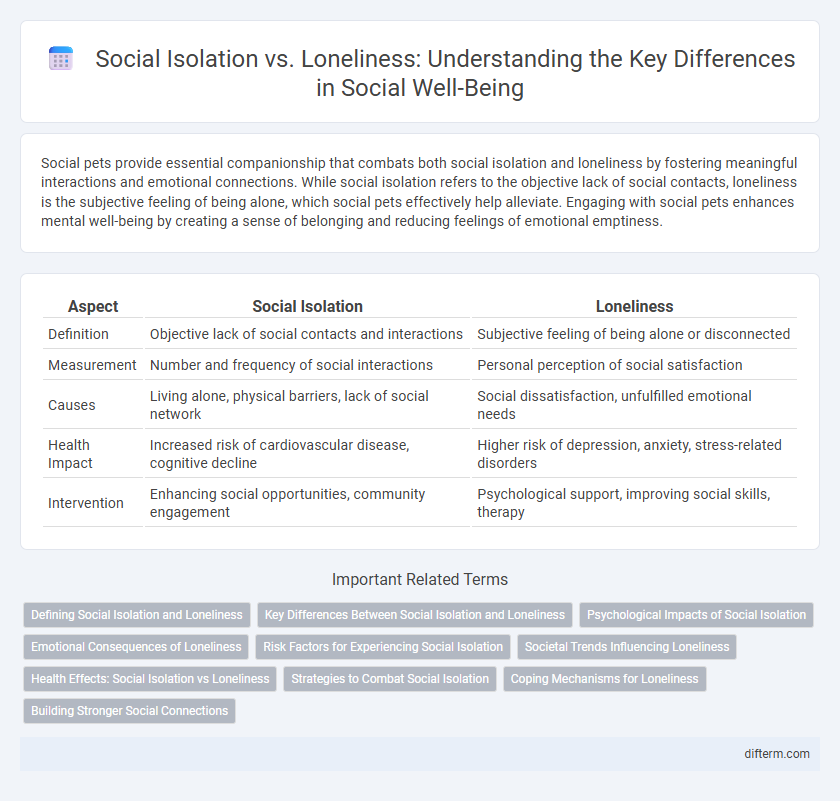Social pets provide essential companionship that combats both social isolation and loneliness by fostering meaningful interactions and emotional connections. While social isolation refers to the objective lack of social contacts, loneliness is the subjective feeling of being alone, which social pets effectively help alleviate. Engaging with social pets enhances mental well-being by creating a sense of belonging and reducing feelings of emotional emptiness.
Table of Comparison
| Aspect | Social Isolation | Loneliness |
|---|---|---|
| Definition | Objective lack of social contacts and interactions | Subjective feeling of being alone or disconnected |
| Measurement | Number and frequency of social interactions | Personal perception of social satisfaction |
| Causes | Living alone, physical barriers, lack of social network | Social dissatisfaction, unfulfilled emotional needs |
| Health Impact | Increased risk of cardiovascular disease, cognitive decline | Higher risk of depression, anxiety, stress-related disorders |
| Intervention | Enhancing social opportunities, community engagement | Psychological support, improving social skills, therapy |
Defining Social Isolation and Loneliness
Social isolation refers to the objective state of having minimal social contact or interactions with others, often resulting in reduced engagement in community or social activities. Loneliness is a subjective emotional experience characterized by feelings of sadness or distress due to perceived gaps between desired and actual social relationships. Understanding the distinction between social isolation and loneliness is crucial for developing effective interventions targeting mental health and social well-being.
Key Differences Between Social Isolation and Loneliness
Social isolation refers to the objective state of having few social contacts or interactions, marked by physical separation from others, whereas loneliness is a subjective emotional experience of feeling disconnected or unsatisfied with one's social relationships. Key differences include that social isolation can exist without feelings of loneliness, and loneliness can occur even when surrounded by people if meaningful connections are lacking. Understanding these distinctions is crucial for targeted interventions addressing mental health, as social isolation often impacts physical health metrics, while loneliness predominantly affects psychological well-being.
Psychological Impacts of Social Isolation
Social isolation significantly increases the risk of depression, anxiety, and cognitive decline, affecting mental health more severely than loneliness alone. Studies show isolated individuals have a 29% higher risk of heart disease and a 32% higher risk of stroke, linking physical and psychological health. Chronic social isolation triggers stress responses, causing elevated cortisol levels that contribute to inflammation and impaired immune function.
Emotional Consequences of Loneliness
Emotional consequences of loneliness include increased risks of depression, anxiety, and heightened stress levels, which profoundly impact mental health. Prolonged social isolation exacerbates feelings of helplessness and lowers self-esteem, leading to a vicious cycle of withdrawal and emotional distress. Research identifies loneliness as a significant predictor of cognitive decline and cardiovascular issues, underscoring its deep physiological and psychological effects.
Risk Factors for Experiencing Social Isolation
Chronic illness, mobility limitations, and advanced age are significant risk factors for experiencing social isolation, often reducing opportunities for meaningful social interactions. Living alone, bereavement, and low socioeconomic status further contribute to increased isolation risk by limiting access to social networks and support systems. Mental health conditions such as depression and anxiety may exacerbate withdrawal behaviors, intensifying feelings of isolation and loneliness.
Societal Trends Influencing Loneliness
Rising digital communication and urbanization contribute to increased social isolation, intensifying feelings of loneliness across diverse demographics. Remote work and fragmented communities reduce face-to-face interactions, weakening social bonds essential for mental well-being. Public health data indicates a surge in loneliness-related health issues, urging societal shifts toward fostering inclusivity and real-world connectivity.
Health Effects: Social Isolation vs Loneliness
Social isolation often leads to measurable health declines such as increased risk of cardiovascular diseases, weakened immune function, and higher mortality rates. Loneliness, characterized by perceived social disconnection, significantly impacts mental health by increasing anxiety, depression, and cognitive decline. Both conditions exacerbate chronic illnesses and reduce overall well-being, emphasizing the need for targeted social interventions to mitigate their adverse health effects.
Strategies to Combat Social Isolation
Effective strategies to combat social isolation include fostering strong social connections through community engagement and support networks, utilizing technology to maintain communication, and participating in group activities or volunteering. Mental health interventions such as counseling and support groups also play a crucial role in addressing both social isolation and the associated feelings of loneliness. Promoting accessibility to social resources and creating inclusive environments enhances individuals' opportunities to connect and reduces the risk of prolonged isolation.
Coping Mechanisms for Loneliness
Effective coping mechanisms for loneliness include engaging in meaningful social activities, such as joining clubs or community groups, which foster a sense of belonging and reduce feelings of isolation. Practicing mindfulness and cognitive-behavioral techniques can help reframe negative thoughts associated with loneliness, promoting emotional resilience. Building and maintaining supportive relationships through regular communication and shared experiences also plays a crucial role in alleviating persistent loneliness.
Building Stronger Social Connections
Building stronger social connections mitigates feelings of social isolation and loneliness by fostering meaningful interactions and emotional support. Engaging in community activities and cultivating authentic relationships enhance mental well-being and resilience. Prioritizing quality over quantity in connections effectively addresses the psychological impacts of solitude.
social isolation vs loneliness Infographic

 difterm.com
difterm.com